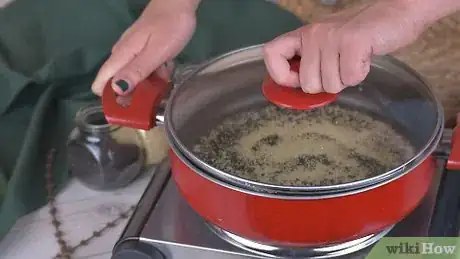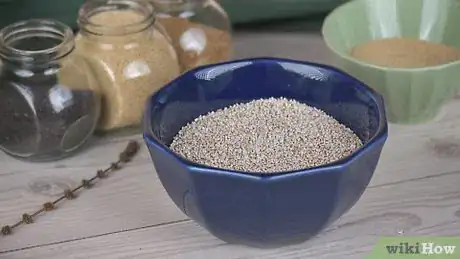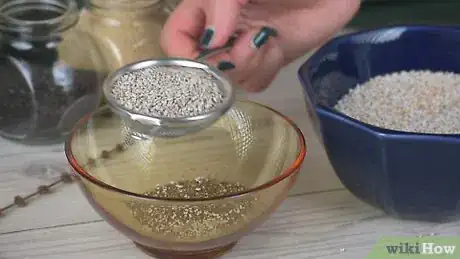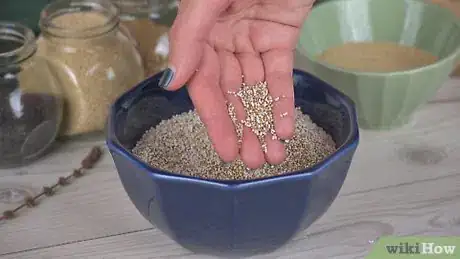This article was co-authored by wikiHow staff writer, Christopher M. Osborne, PhD. Christopher Osborne has been a wikiHow Content Creator since 2015. He is also a historian who holds a PhD from The University of Notre Dame and has taught at universities in and around Pittsburgh, PA. His scholarly publications and presentations focus on his research interests in early American history, but Chris also enjoys the challenges and rewards of writing wikiHow articles on a wide range of subjects.
The wikiHow Culinary Team also followed the article's instructions and verified that they work.
This article has been viewed 22,242 times.
Learn more...
Amaranth isn’t technically a grain—it’s a seed, like quinoa, known as a “pseudograin”—but it cooks like a grain and provides many of the same great health benefits. Packed with protein and other nutrients, amaranth seeds can be simmered in water, popped like popcorn, or even made into a quick breakfast porridge in the microwave. It’s been a staple in parts of the Americas for thousands of years, so go ahead and give amaranth a try for yourself!
Ingredients
- 1 c or 7 oz (200 g) of amaranth seeds
- 1/2 c or 4 fl oz (120 ml) of dairy or non-dairy milk
- 1/2 tsp or 0.05 oz (1.4 g) of ground cinnamon
- 1/2 c or 3 oz (85 g) of frozen sour cherries (optional)
- 1 tbsp or 0.75 oz (21 g) of honey
- 2/3 c or 5.5 fl oz (160 ml) of water
Serves 1-2
Steps
Cooking Amaranth in Water
-
1Bring either 3 or 6 c (0.71 or 1.42 L) of water to a rolling boil. Use the smaller amount of water if you want your cooked amaranth to have a sticky, porridge-like consistency.[1] Choose the larger amount if you prefer your cooked amaranth to have more of a rice-like consistency.[2]
- For the best results, use a heavy-bottomed pot with a tight-fitting lid. You’ll get better heat distribution and more even cooking.
- No matter which amount of water you use, the cooked amaranth seeds will be creamy on the inside while still being firm enough on the outside to “burst” in your mouth when you bite into them.
-
2Stir in 1 cup of amaranth, put on the lid, and reduce the heat to low. Pour in the entire cup—roughly 7 oz (200 g)—of amaranth and give it a quick stir with a long-handled spoon. Place the lid on securely and turn the heat down immediately after. The water should reduce to a simmer—producing individual air bubbles that pop at the surface—within 1-2 minutes.[3]
- This is enough amaranth for roughly 2 servings, depending on your intended final use. If you want to make more, increase the water at either an (approximate) 3:1 or 6:1 water-to-amaranth ratio—for instance, 6 or 12 c (1.4 or 2.8 L) of water and 2 c (about 400 g) of amaranth.
Advertisement -
3Leave the pot to simmer for 15 minutes. Lift the lid no more than once to check that the water is simmering—and not at all if you have a transparent lid! Adjust the heat setting only if necessary to maintain a simmer. Don’t stir the amaranth during cooking.
-
4Remove the amaranth when the water is absorbed if you used less water to start. After 15 minutes of cooking, lift the lid and quickly give the amaranth a stir. If there is still some water visible, pop the lid back on and check again in 1-2 minutes. As soon as you see that all the water is absorbed, turn off the heat, give the amaranth a good stir, and transfer it to a bowl.[4]
- It typically takes about 20 minutes for the amaranth seeds to absorb all the water.
- To clarify, use this method only if you started with 3 c (710 ml) of water per 1 c—roughly 7 oz (200 g)—of amaranth.
-
5Drain the seeds after 20 minutes of cooking if you used more water to start. Turn off the heat, lift off the lid, and give the amaranth a good stir. Use pot holders to pour the amaranth and remaining water into a fine-mesh strainer placed in the sink. Transfer the drained amaranth seeds to a bowl.[5]
- Use this option only if you started with 6 c (1.4 L) of water per 1 c—roughly 7 oz (200 g)—of amaranth.
- To cut back on the stickiness bit more, rinse the cooked and strained amaranth with water from the faucet for 10-20 seconds.
-
6Use the cooked amaranth as a recipe ingredient or substitute. You can eat the cooked amaranth as-is, preferably with either some sweet or savory flavorings added—it’s (more or less) sticky, nutty, and hearty! More often, though, people use cooked amaranth seeds as an ingredient (or as a substitution for another ingredient) in soups, stews, baked goods, and a wide range of other recipes.[6]
- Stir in some sliced peaches, honey, and chopped walnuts for a quick breakfast or dessert. Or, try sauteing the cooked amaranth in a bit of sesame oil with some chopped peppers, onions, and garlic for a quick stir-fry.[7]
- Use the amaranth sooner rather than later, as it will continue to get thicker and stickier. If necessary, keep it sealed in the fridge for up to 2 days.
Popping Amaranth on the Stovetop
-
1Preheat a high-sided, heavy-bottomed pan on high heat for 5 minutes. A heavy-bottomed pot or pan transfers heat more evenly and makes it less likely that your amaranth seeds will burn. And a high-sided pot or pan keeps more of the popping amaranth seeds from escaping![8]
- If you don’t have a high-sided pan, use a fine wire mesh “splatter screen” to cover the pan after you put the amaranth in it. Don’t cover it with a lid.
-
2Pour 1/2 c of amaranth seeds into a bowl. This amount of amaranth is roughly equivalent to 3.5 oz (99 g). Grab a kitchen tablespoon as well, as you’ll need it to dose out the amaranth into batches for popping.[9]
-
3Spread a spoonful of amaranth over the bottom of the heated pan. Scoop into your bowl of amaranth with the tablespoon and use a circular motion to pour the seeds into the pan so that they spread out. If you dump all the amaranth in the center of the pan, they won’t pop evenly and you’ll end up with a lot of burnt, unpopped amaranth seeds![10]
- If you’re using a splatter guard, cover the pan with it immediately after adding the seeds.
-
4Discard the seeds and try again if they don’t start popping right away. Your amaranth seeds will either pop or burn almost immediately, and it all comes down to how hot the pan is. If your pan is scorching hot (as it should be), the seeds will start popping within a few seconds at most. If they don’t start popping within 5 seconds, dump out the seeds and get the pan hotter before trying again.[11]
- If your pan isn’t hot enough, increase the heat (if possible) and let the pan preheat for another 3-5 minutes.
- Throw out the discarded seeds. They’re already partially burned, even if they don’t look like it, and won’t pop properly.
-
5Shake the pan continuously for as long as the seeds are popping. Shaking the pan helps distribute heat evenly and prevents burning. It should take 1 minute at most (and probably less) for the vast majority of the amaranth seeds to pop.[12]
-
6Pour out the amaranth as soon as you hear a gap between popping sounds. Don’t try to pop every last amaranth seed! Otherwise, you’ll just end up burning the seeds that have already popped. Use your ears as your main guide, with your eyes and nose (checking for any burning smells) in supporting roles.[13]
-
7Repeat the process until you’ve popped the whole bowl of seeds. Give the pan 30-60 seconds to heat back up fully, then spread out another spoonful of amaranth seeds. Pop, pour out, add more, and keep going until it’s all finished.[14]
- The whole process will likely take no more than 10 minutes.
-
8Shake the popped amaranth in a wire mesh sieve to remove unpopped seeds. While not as hard on your teeth as unpopped popcorn kernels, unpopped amaranth seeds don’t feel or taste very good! However, shaking the sieve for 20-30 seconds will send all the unpopped seeds down through the small gaps in the mesh and leave you only the properly popped amaranth.[15]
- If you don’t have a sieve or strainer with the right size of mesh, just shake the popped amaranth in a large bowl for 20-30 seconds. The unpopped seeds will work their way to the bottom.
-
9Enjoy your popped amaranth in any number of ways. You can eat it as-is like mini pieces of popcorn, add it to cereal, yogurt, or oatmeal, or sprinkle it on a salad or soup to add some crunch, to name just a few options. Or, mix it with just enough honey to make sweet treat bars—check online for recipes.[16]
- Popped amaranth has a nuttier flavor than popcorn, and it’s very versatile for both sweet and savory applications.
- Store any unused popped amaranth in a sealed container and use it within 1-2 days for the best flavor and texture.
Recipe: 3-Minute Amaranth Porridge
-
1Stir the amaranth and other ingredients together in a medium bowl. Choose a microwave-safe bowl that can hold at least twice the volume of the ingredients you’re adding to it, as the mixture may bubble up as it cooks. Start with the following amounts, which can be adjusted to suit your taste:[17]
- 1 c or 7 oz (200 g) of amaranth seeds.
- 1/2 c or 4 fl oz (120 ml) of dairy or non-dairy milk.
- 1/2 tsp or 0.05 oz (1.4 g) of ground cinnamon.
- 1/2 c or 3 oz (85 g) of frozen sour cherries (optional).
- 1 tbsp or 0.75 oz (21 g) of honey.
- 2/3 c or 5.5 fl oz (160 ml) of water.
-
2Microwave the mixture on high power for 3 minutes. Do not cover the bowl while the porridge cooks. If the porridge starts to bubble over during cooking, stop the microwave for 5-10 seconds and then resume cooking—and use a bigger bowl next time![18]
- Your cooking time may vary based on your microwave model and other factors. If necessary, increase or decrease the cooking time on your next try based on your results this time.
-
3Wait about 1 minute, stir the porridge, and enjoy it! The porridge and the bowl will be very hot, so let them rest in the microwave for at least 30 seconds. Use oven mitts to remove the bowl from the microwave, then give the porridge a good stir. Enjoy the porridge as-is, or add toppings if you wish.[19]
- Try topping the porridge with a bit more milk, fresh blueberries, chopped walnuts, or even some popped amaranth for a little crunch!
- Don’t wait more than about 5 minutes to start eating the porridge, as it will get really sticky and thick. It doesn’t store well for later enjoyment.
References
- ↑ https://www.healingtomato.com/what-is-amaranth/#How_To_Cook_Amaranth
- ↑ https://wholegrainscouncil.org/whole-grains-101/grain-month-calendar/amaranth-may-grain-month
- ↑ https://www.healingtomato.com/what-is-amaranth/#How_To_Cook_Amaranth
- ↑ https://www.healingtomato.com/what-is-amaranth/#How_To_Cook_Amaranth
- ↑ https://wholegrainscouncil.org/whole-grains-101/grain-month-calendar/amaranth-may-grain-month
- ↑ https://wholegrainscouncil.org/whole-grains-101/grain-month-calendar/amaranth-may-grain-month
- ↑ https://www.berkeleywellness.com/healthy-eating/food/article/7-ways-serve-amaranth
- ↑ https://greenhealthycooking.com/popped-amaranth/
- ↑ https://www.cookinglight.com/recipes/popped-amaranth
- ↑ https://greenhealthycooking.com/popped-amaranth/
- ↑ https://greenhealthycooking.com/popped-amaranth/
- ↑ https://www.cookinglight.com/recipes/popped-amaranth
- ↑ https://greenhealthycooking.com/popped-amaranth/
- ↑ https://www.cookinglight.com/recipes/popped-amaranth
- ↑ https://greenhealthycooking.com/popped-amaranth/
- ↑ https://www.cookinglight.com/recipes/popped-amaranth
- ↑ https://www.eatthismuch.com/recipe/nutrition/microwave-amaranth-porridge,906398/
- ↑ https://www.eatthismuch.com/recipe/nutrition/microwave-amaranth-porridge,906398/
- ↑ https://www.eatthismuch.com/recipe/nutrition/microwave-amaranth-porridge,906398/



























































